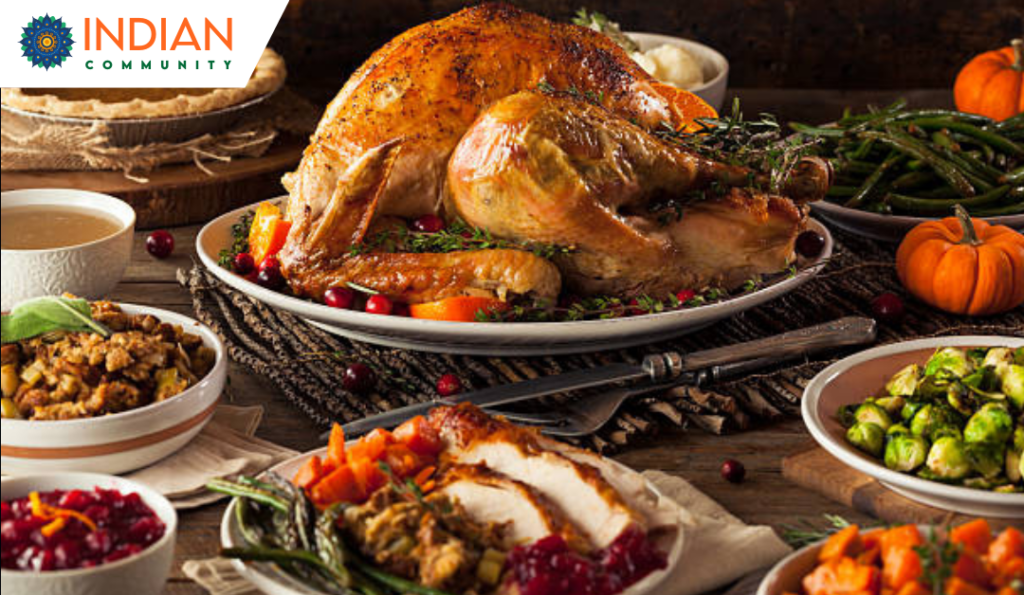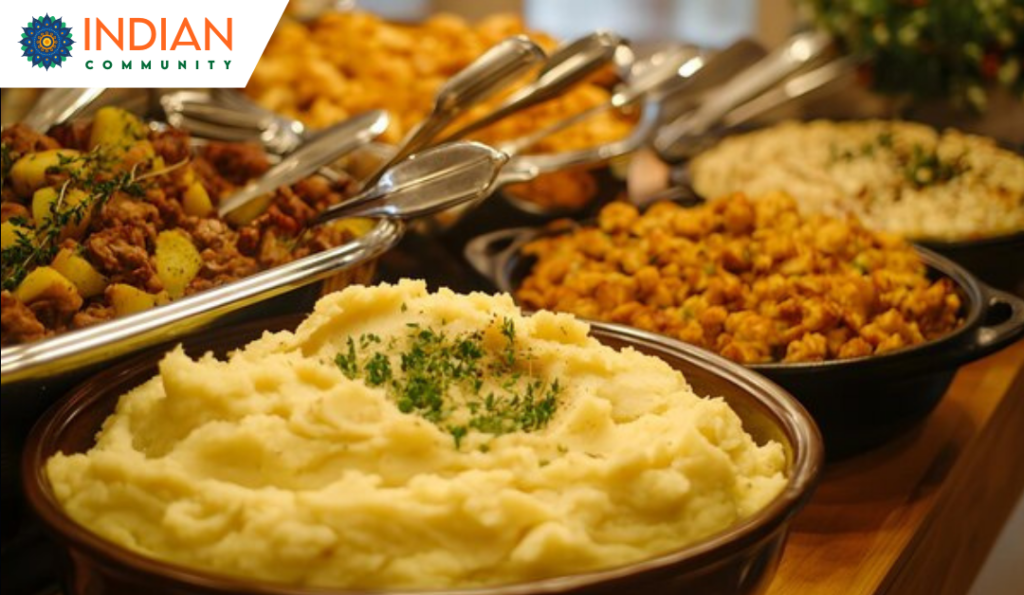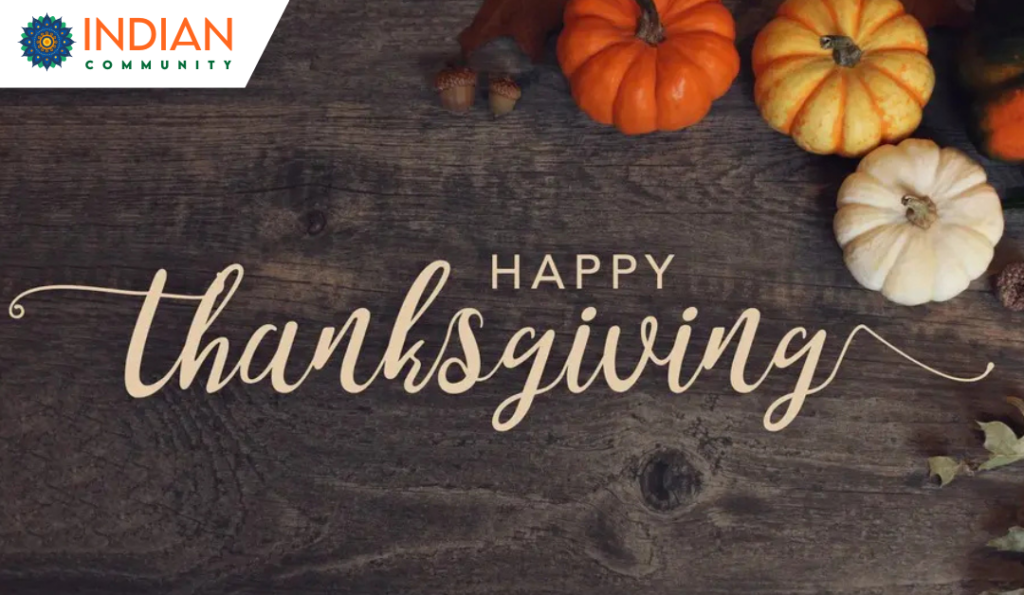For many Indians living in the United States, Thanksgiving is a holiday they may not have grown up with, but it’s quickly become one they’ve embraced. Instead of sticking to the usual turkey, stuffing, and cranberry sauce, Indian families add their own “masala” to the holiday, crafting a Thanksgiving celebration that’s distinctly Indian and distinctly American. It’s a time for gratitude, family, and lots (and lots) of food.
Here’s how NRIs (non-resident Indians) are giving Thanksgiving a desi twist—complete with Bollywood, chai, and even Tandoori turkey!
1. Family, Food, and Festivity: Thanksgiving Meets Diwali Vibes
Thanksgiving is all about family, food, and gratitude, values that resonate deeply with Indians. In fact, Thanksgiving reminds many NRIs of traditional Indian harvest festivals like Pongal, Lohri, and Makar Sankranti. Just as these Indian holidays are about giving thanks for abundance, Thanksgiving feels familiar, making it easy for Indian families to embrace.
It also doubles as another reason to gather as a family, sometimes even traveling across states to be together. Grandparents, cousins, and friends come over, making it feel like a mini-Diwali in November. The house is alive with the smell of spices, the laughter of loved ones, and sometimes the sounds of Bollywood music in the background.
2. The Indian-American Thanksgiving Feast: A Masala Medley
Forget the dry turkey and bland mashed potatoes. When NRIs celebrate Thanksgiving, the food becomes a lively fusion of Indian spices and American classics. Here’s how a typical Indian-American Thanksgiving feast looks:

Tandoori Turkey: Yes, the centerpiece is still a turkey, but this bird has a major makeover! Marinated in spices like cumin, coriander, garam masala, and yogurt, the turkey takes on a flavor that’s uniquely Indian. Some families even take it up a notch by roasting it in a tandoor or smothering it in a rich masala sauce. The result? Turkey that’s bursting with flavor and spice.

The Sides—Fusion Style: While some might stick with mashed potatoes, others go all out with dishes like spiced mashed sweet potatoes or saag paneer casserole. Cranberry chutney (with a hint of cumin) replaces the usual cranberry sauce, and bread stuffing gets a desi upgrade with spices, nuts, and even a touch of curry powder. Dal, vegetable curries, and spiced rice pilafs join the feast, creating a true fusion of East meets West.

Desserts, Desi-Style: Pumpkin pie is nice, but add some Indian flair, and it becomes unforgettable. Think chai-spiced pumpkin pie, cardamom-scented cheesecakes, or a side of gulab jamun and kheer. You might even see a Gajar ka Halwa (carrot pudding) make an appearance, alongside the American pie.
3. Thanksgiving Morning: The Macy’s Parade and a Dose of Bollywood
Thanksgiving morning traditions look different in every Indian household, but there are a few favorites. The Macy’s Thanksgiving Day Parade is a hit with families and often kicks off the day, bringing a sense of American festivity. But once the giant floats are done, the TV sometimes switches over to a Bollywood classic, from Sholay to DDLJ, for a bit of nostalgia.
For many families, the parade is followed by making chai and snacking on Indian breakfast dishes, like poha or upma, to fuel up before the big cooking marathon begins. Thanksgiving morning is about a slow start, relaxing, and connecting over food and memories.
4. A New Tradition of Gratitude with an Indian Twist
Thanksgiving gives Indian families a chance to pause, reflect, and express gratitude. Many families start the meal with a prayer or a family ritual, blending the American concept of giving thanks with Indian spiritual practices. Some may perform a small puja or light a diya, symbolizing gratitude for health, happiness, and togetherness.
In some homes, families go around the table, with each person sharing what they’re grateful for. It’s a simple, heartfelt moment that resonates deeply with NRIs, who often use it as a chance to celebrate their journey and reflect on their unique position as Indians in America.
5. Giving Back: The Spirit of “Seva” Meets Thanksgiving
For Indian families, Thanksgiving is more than just a time to eat—it’s a time to give back. Many NRIs embrace “seva,” or selfless service, as part of the holiday tradition. Families volunteer at shelters, donate food, or participate in community events to help those in need. This spirit of giving makes Thanksgiving even more meaningful, bridging Indian values with the American holiday.
For those who may be far from family, Friendsgiving celebrations have also become popular. Friends gather for a Thanksgiving meal and combine their recipes, stories, and traditions, creating a chosen family in their adopted home. It’s a reminder that gratitude transcends distance, making everyone feel a bit more at home.
6. A Celebration That Blends Cultures for the Next Generation
Thanksgiving in Indian homes is a blend of tradition and new beginnings, especially for kids growing up in the U.S. They’re getting the best of both worlds—learning about an American holiday while staying connected to Indian culture. From hearing stories about Diwali and Pongal to helping make the Thanksgiving turkey, the younger generation is growing up with a multicultural identity that embraces diversity.
For parents and grandparents, Thanksgiving is a chance to create new family traditions, share stories of their homeland, and build memories that their children will pass on.

